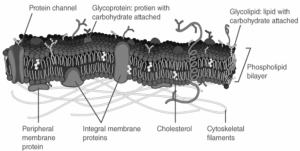The plasma membrane is a membrane found in all cells that separates the inside from the outer parts of the cell. In plant and bacterial cells, a cell wall is found to be linked to the plasma membrane on the outside. The plasma membrane is made up of a semipermeable lipid layer. It is in charge of regulating the circulation of materials and chemicals into and out of the cell.
The plasma membrane contains membrane proteins in addition to a lipid layer that sits between the phospholipids and maintains fluidity at a variety of temperatures. This also contains integral proteins that pass through the membrane and act as membrane transporters, as well as peripheral proteins that adhere to the cell membrane’s edges. It functions as enzymes that shape the cell. The plasma membrane is selectively permeable to organic molecules and ions, and it controls particle passage in and out of organelles and cells.
Structure of Plasma membrane

A fluid mosaic of proteins, lipids, and carbohydrates makes up the plasma membrane. Ions and water-soluble compounds can only pass-through membranes via carriers, transmembrane channels, and pumps. Transmembrane proteins provide nutrients to the cell, control the internal ion concentration, and establish a transmembrane electrical potential. Cystic fibrosis is a human disease caused by a single amino acid change in one Cl channel and plasma membrane pump. Lipids can make up anywhere from 20% to 80% of the membrane depending on where it is located in the body, with proteins accounting for the rest. It is made up of a phospholipid bilayer, which is two phospholipid layers stacked on top of each other. Phospholipids are lipids that have a phosphate group attached. The phospholipids have one head and two tails, with the head being polar and hydrophilic (loving water). Nonpolar and water-averse or hydrophobic, on the other hand, are tails.
Plasma Membrane – Components
It is made up of the following elements:
- Phospholipids – constitute the membrane’s ultimate fabric.
- Peripheral proteins are proteins that are found on the outer or inner surface of phospholipid bilayers but not in the hydrophobic core.
- Cholesterol – It is folded between the phospholipid membrane’s hydrophobic tails.
- Carbohydrates – carbohydrate molecules are discovered coupled to lipids or proteins on the extracellular side of the membrane, resulting in glycolipids and glycoproteins.
- Integral proteins – These have been discovered to be embedded in phospholipid bilayers.
Plasma membrane Functions
This membrane is made up of a phospholipid bilayer that has been implanted with proteins. It provides a durable barrier between two aqueous compartments in the plasma membrane, one on the outside and one on the inside of a cell. The implanted proteins provide specialised activities such as cell-cell identification and targeted chemical transport. The plasma membrane protects the cell while also maintaining a consistent environment within the cell. It is in charge of carrying out several functions. To allow substances such as white and red blood cells to travel, it must be flexible enough to let them change shape and pass – through blood capillaries.
Furthermore, it anchors the cytoskeleton to give a cell shape and connects with extracellular matrix and other cells to help the cells form a tissue. It also keeps the cell potential stable. The plasma membrane is in charge of interfacing with other cells, which can be glycoproteins or lipid proteins. The membrane also aids proteins in monitoring and maintaining the chemical climate of the cell, as well as in the movement of molecules across the membrane.
CONCLUSION
The cell membrane’s chemical nature makes it extremely flexible, making it the ideal border for quickly growing and dividing cells. The membrane, on the other hand, is a powerful barrier that allows some dissolved chemicals, or solutes, to pass through while preventing others. Small molecules and lipid-soluble molecules can pass through the membrane, but the lipid bilayer efficiently repels the numerous big, water-soluble molecules and electrically charged ions that the cell needs to survive.
Intrinsic proteins transport these vital substances in a variety of ways: some are open channels that allow ions to diffuse directly into the cell; others are “facilitators” that help solutes diffuse past the lipid screen; and still others are “pumps” that force solutes through the membrane when they are not concentrated enough to diffuse spontaneously. Particles that are too big to be dispersed or pumped are frequently ingested or disgorged intact by a membrane opening and shutting.
 Profile
Profile Settings
Settings Refer your friends
Refer your friends Sign out
Sign out




